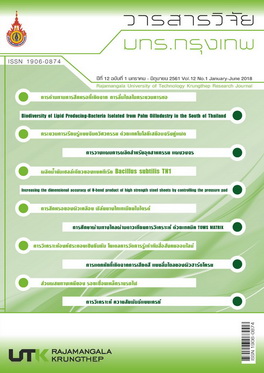กระบวนการเรียนรู้แบบจินตวิศวกรรมด้วยเทคโนโลยีเสมือนจริงคู่แฝดในสภาพแวดล้อม การเรียนรู้ห้องปฏิบัติการเสมือน
คำสำคัญ:
การเรียนรู้แบบจินตวิศวกรรม, เทคโนโลยีเสมือนจริงคู่แฝด, สภาพแวดล้อมห้องปฏิบัติการเสมือนจริงบทคัดย่อ
การเขียนบทความวิชาการครั้งนี้มีวัตถุประสงค์เพื่อพัฒนาศึกษากระบวนการเรียนรู้แบบจินตวิศวกรรมด้วยเทคโนโลยีเสมือนจริงคู่แฝดในสภาพแวดล้อมการเรียนรู้ห้องปฏิบัติการเสมือน โดยแบ่งการศึกษาบทความวิชาการ ออกเป็น 2 ขั้นตอน คือ 1) การสังเคราะห์เอกสารและงานวิจัยที่เกี่ยวข้องกับการพัฒนากระบวนการเรียนรู้แบบจินตวิศวกรรมผ่านเทคโนโลยีเสมือนจริงคู่แฝดหรือเทคโนโลยีความเป็นจริงเสมือนแบบผสม 2) ความเหมาะสมของกระบวนการเรียนรู้ของกระบวนการเรียนรู้แบบจินตวิศวกรรมผ่านเทคโนโลยีเสมือนจริงคู่แฝด ผลการศึกษาพบว่ากระบวนการเรียนรู้ของกระบวนการเรียนรู้แบบจินตวิศวกรรมผ่านเทคโนโลยีเสมือนจริงคู่แฝด เพื่อเพิ่มความรู้ความเข้าใจกระบวนการเรียนรู้กระบวนการเรียนรู้แบบจินตวิศวกรรมด้วยเทคโนโลยีเสมือนจริงคู่แฝด ประกอบด้วย 6 ขั้นตอน ต่อไปนี้ 1) การจินตนาการ 2) การออกแบบ 3) การพัฒนา 4) การนำเสนอ 5) การปรับปรุง และ 6) การประเมิน จากนั้นได้ทำการศึกษา ห้องปฏิบัติการเสมือนจริง พบว่าห้องปฏิบัติการประกอบไปด้วย 6 ปัจจัย ได้แก่ 1) ความยืดหยุ่น 2) ความสะดวก 3) การโต้ตอบ 4) การสร้างแรงจูงใจ 5) ประสิทธิภาพ 6) การให้ความร่วมมือ และสภาพแวดล้อมการเรียนรู้ ประกอบไปด้วย 5 องค์ประกอบ 1) การจัดการทรัพยากร 2) บุคคล 3) การฝึกอบรม 4) การพัฒนา 5) ประสบการณ์การเรียนรู้
เอกสารอ้างอิง
[2] ปรัชญนันท์ นิลสุขและปณิตา วรรณพิรุณ. การเรียนรู้แบบจินตวศิวกรรม. วารสารพัฒนาเทคนิคศึกษา ปีที่ 25 ฉบับที่ 86 เมษายน - มิถุนายน 2556. หน้า 33-37.
[3] Walt Disney Imagineering, Walt Disney Imagineering a Behind the Dreams Look at Making the Magic Real. China: Welcome Enterprises; 2010.
[4] Guzdial, M. and Tew, E.A. Imagineering Inauthentic Legitimate Peripheral Participation : An Instructional Design Approach for Motivating Computing Education. The Second International Computing Education Research Workshop : ICER’06, Canterbury; United Kingdom; September 9–10, 2006.
[5] Yates, D. National Grid Support for New Models. The Imagineer. Issue 4 Spring. de Jong, T., Linn, M. C., & Zacharia, Z. C. Physical and Virtual Laboratories in Science and Engineering Education. Science, 340 (6130); 305–308, 2012.
[6] Langford, D. Imagineering. Montana : Langford International, Inc; 2010.
[7] อดิศักดิ์ จำปาทอง. Digital Sphrere โลกยุคใหม่ของสื่อดิจิทัล. หนังสือพิมพ์กรุงเทพธุรกิจ. ฉบับประจำวันพุธที่ 21 มีนาคม 2556.
[8] อัศวิน เนตรโพธิ์แก้ว. นวัตกรรมสื่อสังคมกับประชาคมอคติ วารสารนิเทศศาสตร์และนวัตกรรมนิด้า, สถาบันบัณฑิตพัฒน บริหารศาสตร์, ปีที่ 2 ฉบับที่ 2 กรกฎาคม-ธันวาคม 2558.
[9] โกวิทย์ ทะลิ. มุมมองที่แตกต่าง งานออกแบบมีเดียสามมิติเสมือนจริง Augmented reality Design. ปีที่ 15 ฉบับที่ 2 (ธันวาคม 2555 - พฤษภาคม 2556) วารสารศิลปกรรมบูรพา; 2555.
[10] Catherine Lombardozzi. Talent Development in the Digital Age Designing Learning Environments, Atlanta, GA, 2017. Avaliable from: https://l4lp.com/TDDA-LED
[11] F. Qiyue, Imagineering. Business Innovation from the Experience Perspective, 2013. Available from: https://www.fongqiyue.com/Imagineering_FongQiyue.
[12] L. J. Prosperi, “The Imagineering Model: Applying Disney Theme Park Design Principles to Instructional Design,2014. Available from: https://www.slideshare. net/louprosperi1/the-imagineer ingmodel.
[13] P. Nilsook, N. Utakrit, and J. Clayden, “Imagineering in Education: A Framework to Enhance Students’ Learning Performance and Creativity in Thinking,” educational technology, vol. 54, no.1, 2014, p. 14-20.
[14] Techakosit, S., & Nilsook, P. The learning process of scientific imagineering through AR in order to enhance STEM literacy. International Journal of Emerging Technologies in Learning, 11(7), 2016, p. 57–63. https:// doi.org/10.3991/ijet.v11i07.5357
[15] G. Kuiper and B. Smit, Imagineering: innovation in the experience economy 2014. Croydon: CPI Group (UK) Ltd, 2014.
[16] F. Pengcheng, Z. Mingquan and W. Xuesong, “The Significance and Effectiveness of Augmented Reality in Experimental Education,” in Proc. E -Business and E-Government (ICEE), 2011, pp.1-4. Avaliable from: https:// dx.doi.org/10.1109/icebeg.2011.5881654
[17] M. Antonioli, C. Blake, and K. Sparks, “Augmented Reality Applications in Education,” Journal of Technology Studies, September 1, 2014, pp. 96-107.
[18] I. Radu, “Why Should My Students Use AR? A Comparative Review of the Educational Impacts of Augmented-Reality,” in Proc. IEEE International Symposium on Mixed and Augmented Reality 2012, 2012, pp. 313-314. Avaliable from: https://dx.doi.org/10. 1109/ ISMAR.2012.6402590
[19] HK Wu, S Wen-Yu Lee, HY Chang and JC Liang, “Current status, opportunities and challenges of augmented reality in education,”Computers & Education, vol.62, 2013, pp. 41-49. Avaliable from: https://dx.doi.org/10.1016 /j.compedu.2012.10.024
[20] C. C. Kuhlthau, “Guided Inquiry: School Libraries in the 21st Century,” School Libraries Worldwide, vol.16, no.1, 2010, pp. 1728.
[21] K. H. Cheng and C. C. Tsai, “Affordances of Augmented Reality in Science Learning: Suggestions for Future Research,” J Sci Educ Techno, vol. 22, 2013, pp. 449-462. Avaliable from: https://dx.doi.org/10.1007/ s10956-012-9405-9
ดาวน์โหลด
เผยแพร่แล้ว
รูปแบบการอ้างอิง
ฉบับ
ประเภทบทความ
สัญญาอนุญาต
กองบรรณาธิการวารสารวิชาการ มหาวิทยาลัยเทคโนโลยีราชมงคลกรุงเทพ มีความยินดีที่จะรับบทความจากอาจารย์ นักวิจัย นักวิชาการทั้งภายในและภายนอกมหาวิทยาลัย ในสาขาวิชาวิทยาศาสตร์และเทคโนโลยี ได้แก่ สาขาวิชาวิทยาศาสตร์ วิศวกรรมศาสตร์ และสาขาอื่นๆ ที่เกี่ยวข้อง รวมถึงสาขาต่างๆ ที่มีการบูรณาการข้ามศาสตร์ที่เกี่ยวข้องวิทยาศาสตร์และเทคโนโลยี ที่เขียนเป็นภาษาไทยหรือภาษาอังกฤษ ซึ่งผลงานวิชาการที่ส่งมาขอตีพิมพ์ต้องไม่เคยเผยแพร่ในสิ่งพิมพ์อื่นใดมาก่อน และต้องไม่อยู่ในระหว่างการพิจารณาของวารสารอื่น
การละเมิดลิขสิทธิ์ถือเป็นความรับผิดชอบของผู้ส่งบทความโดยตรง บทความที่ได้รับการตีพิมพ์ต้องผ่านการพิจารณากลั่นกรองคุณภาพจากผู้ทรงคุณวุฒิและได้รับความเห็นชอบจากกองบรรณาธิการ
ข้อความที่ปรากฏอยู่ในแต่ละบทความที่ตีพิมพ์ในวารสารวิชาการเล่มนี้ เป็นความคิดเห็นส่วนตัวของผู้เขียนแต่ละท่าน ไม่เกี่ยวข้องกับมหาวิทยาลัยเทคโนโลยีราชมงคลกรุงเทพแต่อย่างใด ความรับผิดชอบด้านเนื้อหาและการตรวจร่างบทความแต่ละบทความเป็นของผู้เขียนแต่ละท่าน หากมีความผิดพลาดใดๆ ผู้เขียนแต่ละท่านจะต้องรับผิดชอบบทความของตนเองแต่ผู้เดียว
กองบรรณาธิการขอสงวนสิทธิ์มิให้นำเนื้อหา หรือข้อคิดเห็นใดๆ ของบทความในวารสารวิชาการ มหาวิทยาลัยเทคโนโลยีราชมงคลกรุงเทพ ไปเผยแพร่ก่อนได้รับอนุญาตจากกองบรรณาธิการ อย่างเป็นลายลักษณ์อักษร ผลงานที่ได้รับการตีพิมพ์ถือเป็นลิขสิทธิ์ของวารสาร






